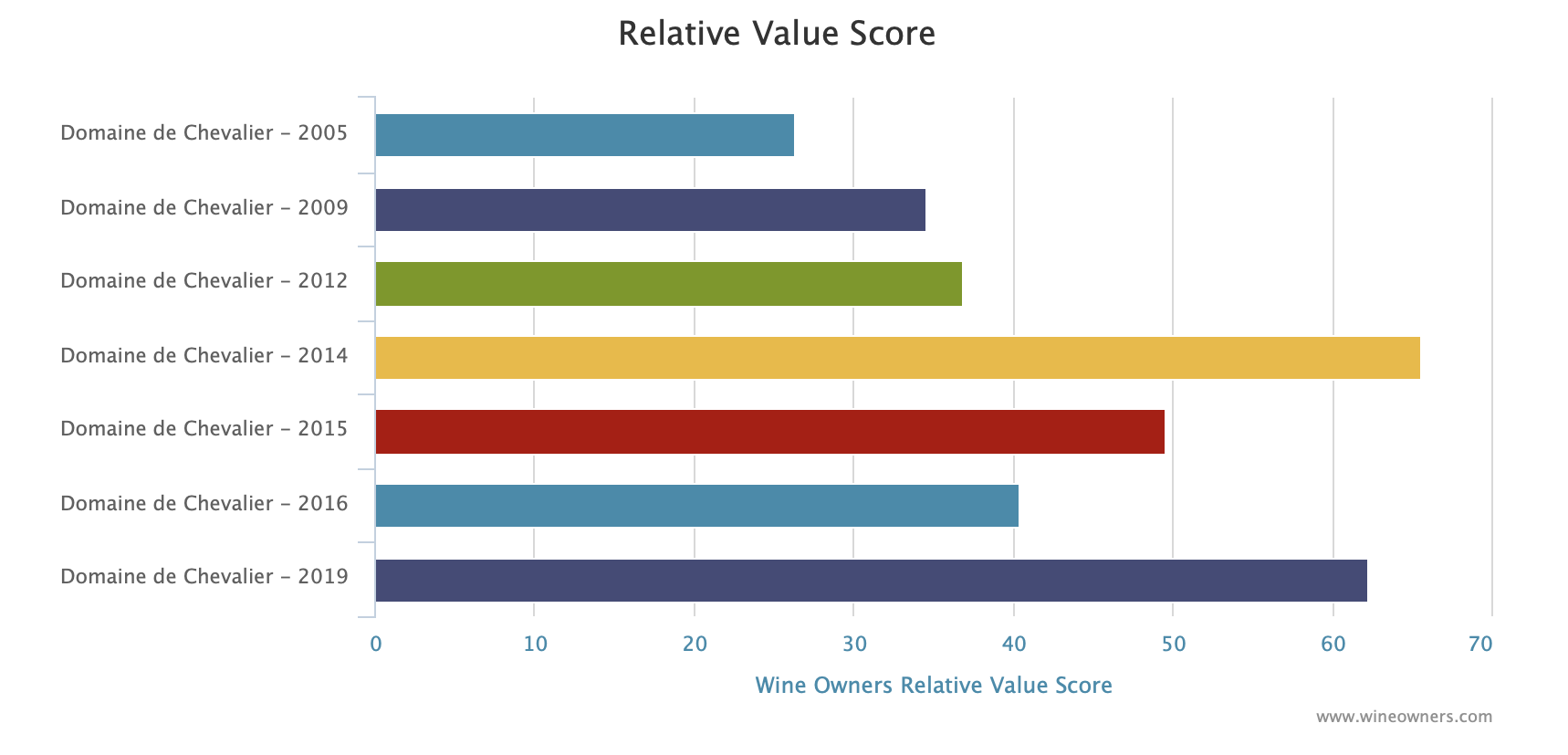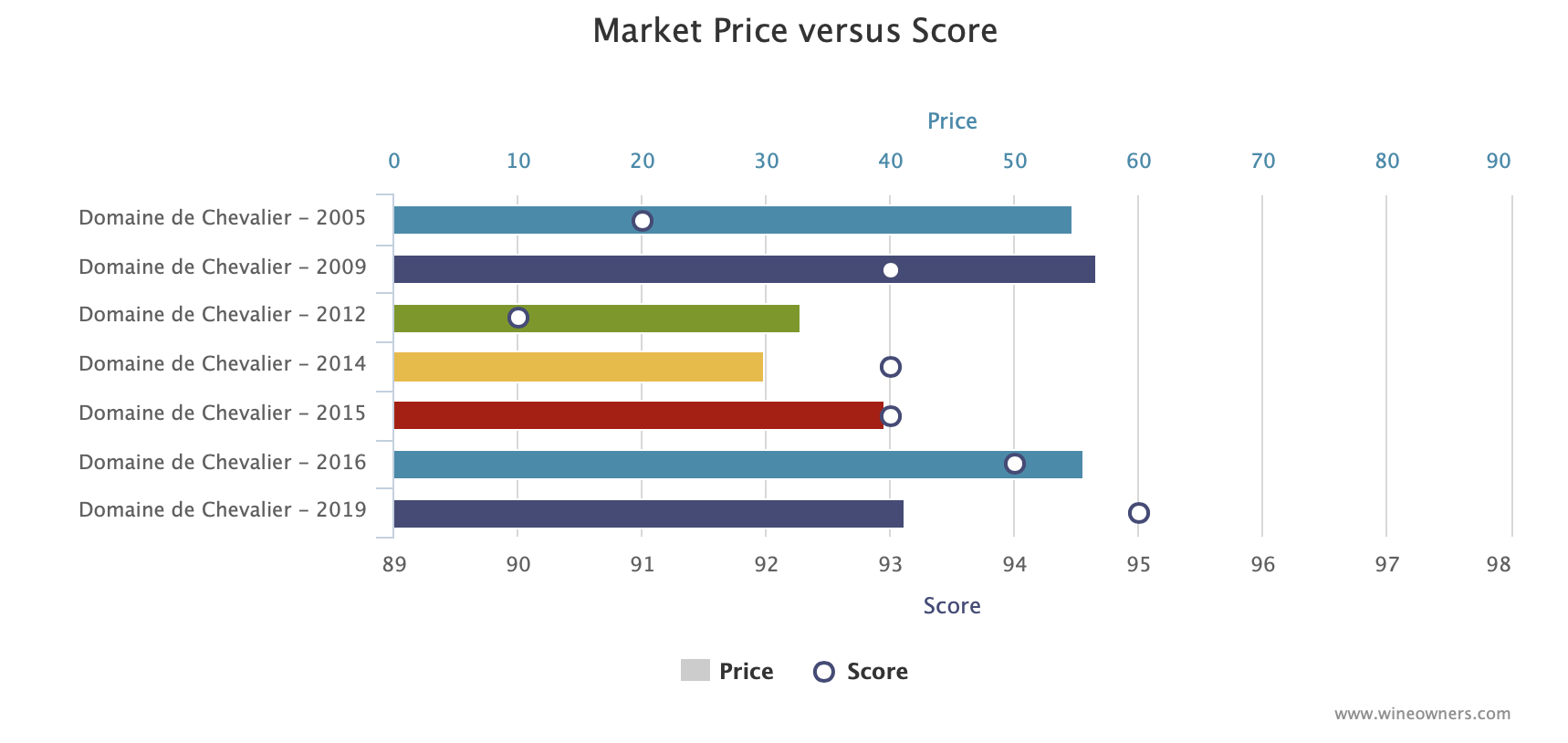by Wine Owners
Posted on 2020-06-04
Chevalier is out this morning at £247 per 6, a perennial favourite and on the back of a seemingly great success in 2018. Hopefully in 2019 they’ll have tamed the merlot alcohols which hit 15 degrees in 2018. Bordeaux being blends saved the day and early pickings of Cabernet brought the assemblage down to under 14 degrees. Still, that kind of inherent excessiveness does make you wonder. Chevalier does age with unusually consistent grace no matter the kind of vintage.
Relative value analysis points to 2014 as being a rather decent pick of an excellent run of recent vintages. 2019 is fairly priced for collectors of this lovely estate but not to attract the short term profiteers.


Banner Image: http://www.domainedechevalier.com
by Wine Owners
Posted on 2018-10-17
When tasted from barrel in the spring of 2017, it was very evident that this was a vintage with loads of extract, with one of the highest ever IPT levels ever recorded in Bordeaux. IPT is a measure of the combined phenolic compounds in the juice - principally tannins and colorants responsible for the red, purple and blue hues in grapes. Large bunches of rather small berries meant high skin to juice ratios.
We suspected that the finest wines were those who extractions were gentle - neatly summarised by Frédéric Faye at Chateau Figeac who described their fermentation process as an ‘infusion’ with the gentlest of extractions achieved from the submerged cap.
With the proviso that the 2016s have been in bottle for as little as 3 months, this was an opportunity to re-taste a selection and test our original impressions from 18 months ago.
The more extracted wines with highest IPT levels were evident, and at this stage it has to be said that they were the least harmonious. Where there was a desire to make full use of, or to accentuate, all the elements proffered by nature, the palate tended to be dominated by raw power, the scale undeniable but at the expense of charm for now.
The structure of 2016, hidden under a cloak of velvety fruit and sweet tannins when barrel samples, was much more evident now the wines are in bottle, and this structure allied to tremendously aromatic fruit in the best examples, affirms 2016 as a vintage with some truly great wines in the making.
It’s not just a great cabernet sauvignon vintage either, with some of the right bank merlots absolutely stunning. La Conseillante that had seemed a little sweet and svelte at the property in April 2017 is now brilliantly pitched, with extremely expressive and aromatic fruit held in check by an impressive frame of tannins.
What was slightly surprising however, was the wide variation. Those who are tempted to categorise 2016 as a uniformly great vintage will be disappointed; there is plenty of dull wine. The difference between the vintage's heights and the good average is a chasm.
The Northern Medoc had an especially successful vintage, with Cantermerle showing excellent concentration and focus, and my pick of the appellation at en primeur, Citran, showing all of its former promise and more. Could this be the bargain of the vintage?
Domaine de Chevalier has made an epic red, with great substance and lovely resonance, and on this showing had the better of the high-in-cabernet-franc Carmes Haut-Brion. Though evidently fine fruited, Haut Bailly’s firm tannins are a bit overwhelming for now. Both Pape Clement and Smith Haut Lafitte major on great substance and scale, but show a raw or unknit character at this early stage.
Canon was showing very defined fruit with loads of grip but for now felt very slightly loose on the finish. Figeac has managed to combine stunning definition, texture, harmony and length and on this showing must be a 100 point wine in the making.
Gazin was absolutely charming with an impressively solid core. La Conseillante as already mentioned was a hit.
St Estephe and Pauillac were as good as expected given how fine the Cabernet was from this upper part of the Medoc peninsular, and wines from Cos Labory and Phelan Segur were notably excellent at their price levels.
Clerc Milon had stood out as exceptional in April 2017, and now in bottle shows impressive density, a huge finish and attractive gaminess. D’Armailhac was extremely exciting, packed with red fruit and finely beaded acidity and plenty of accompanying structure. Pichon Longueville Comtesse was one of the stars of the en primeur tasting and once again stood out for its super-refinement: unquestionably a top wine of the vintage.
In St Julien the Bartons stood out. Langoa was svelte, intense, showed gorgeous scale and definition at a very attractive price point. Leoville Barton was another league and heads above the other St Juliens. Huge, but super fresh, light-footed, with a mouthwatering blood orange infused core and a very direct, linear finish. One of the greatest wines of the vintage.
Lagrange was fine, the tannins so ripe and silky that their velvety texture cloak its underlying structure, just as it did when tasted in London a year ago. Talbot was back to it’s very best, likely up there with its beautifully balanced 1982.
The Margaux appellation in the main was not quite as exciting as the magnificent 2015s, a vintage in which the commune excelled. However one stood out for it’s stunning definition and extraordinary elegance. A fitting wine to finish this round-up of 2016s in bottle. Beautifully textured. A wine that simply flows across the palate with effortless grace. It helps that it’s also one of the most under-rated wines in the whole of Bordeaux, sitting as it does on great terroir. The wine in question is Chateau Dufort-Vivens, Second Growth Margaux, fully biodynamic, and an outstanding success in 2016.

